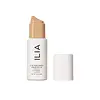What's inside
What's inside
 Key Ingredients
Key Ingredients

 Benefits
Benefits

 Concerns
Concerns

 Ingredients Side-by-side
Ingredients Side-by-side

Zinc Oxide 10%
Cosmetic ColorantSqualane
EmollientAscorbic Acid
AntioxidantShea Butter Ethyl Esters
EmollientPolymethylsilsesquioxane
Simmondsia Chinensis Seed Oil
EmollientLimnanthes Alba Seed Oil
Skin ConditioningButyloctyl Salicylate
Skin ConditioningCaprylic/Capric Triglyceride
MaskingC9-12 Alkane
SolventC12-15 Alkyl Benzoate
AntimicrobialNiacinamide
SmoothingSilica Silylate
EmollientMethylpropanediol
SolventLecithin
EmollientTocopherol
AntioxidantSilica
AbrasivePolyglyceryl-2 Dipolyhydroxystearate
Skin ConditioningEthylene/Propylene/Styrene Copolymer
Allantoin
Skin ConditioningBisabolol
MaskingCaprylyl Glycol
EmollientPhenylpropanol
MaskingOryza Sativa Bran Extract
Skin ConditioningButylene/Ethylene/Styrene Copolymer
Helianthus Annuus Extract
EmollientPolyglyceryl-4 Diisostearate/Polyhydroxystearate/Sebacate
EmulsifyingPentaerythrityl Tetra-Di-T-Butyl Hydroxyhydrocinnamate
AntioxidantRosmarinus Officinalis Leaf Extract
AntimicrobialHydrogenated Lecithin
EmulsifyingCI 77491
Cosmetic ColorantCI 77492
Cosmetic ColorantCI 77499
Cosmetic ColorantZinc Oxide 10%, Squalane, Ascorbic Acid, Shea Butter Ethyl Esters, Polymethylsilsesquioxane, Simmondsia Chinensis Seed Oil, Limnanthes Alba Seed Oil, Butyloctyl Salicylate, Caprylic/Capric Triglyceride, C9-12 Alkane, C12-15 Alkyl Benzoate, Niacinamide, Silica Silylate, Methylpropanediol, Lecithin, Tocopherol, Silica, Polyglyceryl-2 Dipolyhydroxystearate, Ethylene/Propylene/Styrene Copolymer, Allantoin, Bisabolol, Caprylyl Glycol, Phenylpropanol, Oryza Sativa Bran Extract, Butylene/Ethylene/Styrene Copolymer, Helianthus Annuus Extract, Polyglyceryl-4 Diisostearate/Polyhydroxystearate/Sebacate, Pentaerythrityl Tetra-Di-T-Butyl Hydroxyhydrocinnamate, Rosmarinus Officinalis Leaf Extract, Hydrogenated Lecithin, CI 77491, CI 77492, CI 77499
 Reviews
Reviews

Ingredients Explained
These ingredients are found in both products.
Ingredients higher up in an ingredient list are typically present in a larger amount.
Niacinamide is a multitasking form of vitamin B3 that strengthens the skin barrier, reduces pores and dark spots, regulates oil, and improves signs of aging.
And the best part? It's gentle and well-tolerated by most skin types, including sensitive and reactive skin.
You might have heard of "niacin flush", or the reddening of skin that causes itchiness. Niacinamide has not been found to cause this.
In very rare cases, some individuals may not be able to tolerate niacinamide at all or experience an allergic reaction to it.
If you are experiencing flaking, irritation, and dryness with this ingredient, be sure to double check all your products as this ingredient can be found in all categories of skincare.
When incorporating niacinamide into your routine, look out for concentration amounts. Typically, 5% niacinamide provides benefits such as fading dark spots. However, if you have sensitive skin, it is better to begin with a smaller concentration.
When you apply niacinamide to your skin, your body converts it into nicotinamide adenine dinucleotide (NAD). NAD is an essential coenzyme that is already found in your cells as "fuel" and powers countless biological processes.
In your skin, NAD helps repair cell damage, produce new healthy cells, support collagen production, strengthen the skin barrier, and fight environmental stressors (like UV and pollution).
Our natural NAD levels start to decline with age, leading to slower skin repair, visible aging, and a weaker skin barrier. By providing your skin niacinamide, you're recharging your skin's NAD levels. This leads to stronger, healthier, and younger looking skin.
Another name for vitamin B3 is nicotinamide. This vitamin is water-soluble and our bodies don't store it. We obtain Vitamin B3 from either food or skincare. Meat, fish, wheat, yeast, and leafy greens contain vitamin B3.
The type of niacinamide used in skincare is synthetically created.
Learn more about Niacinamide